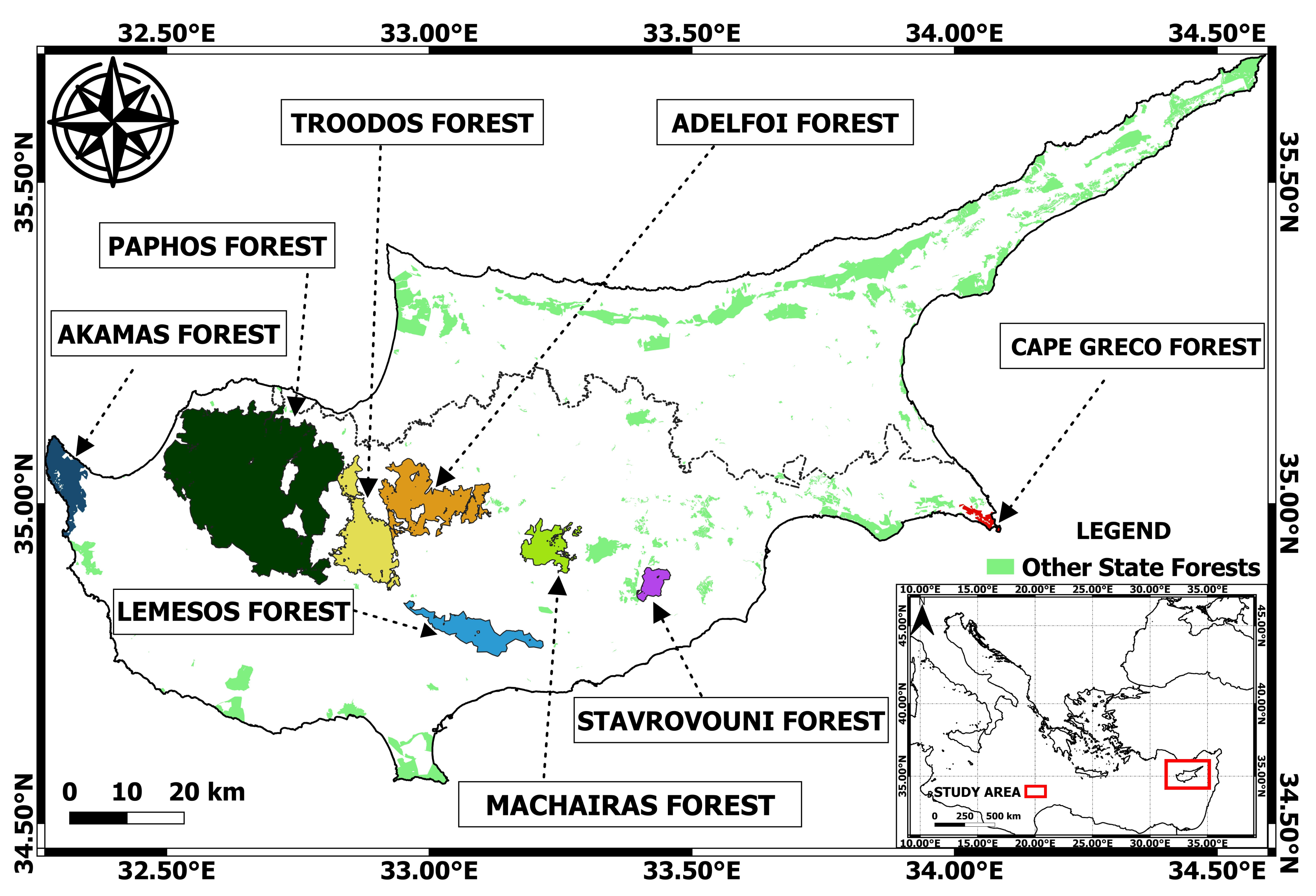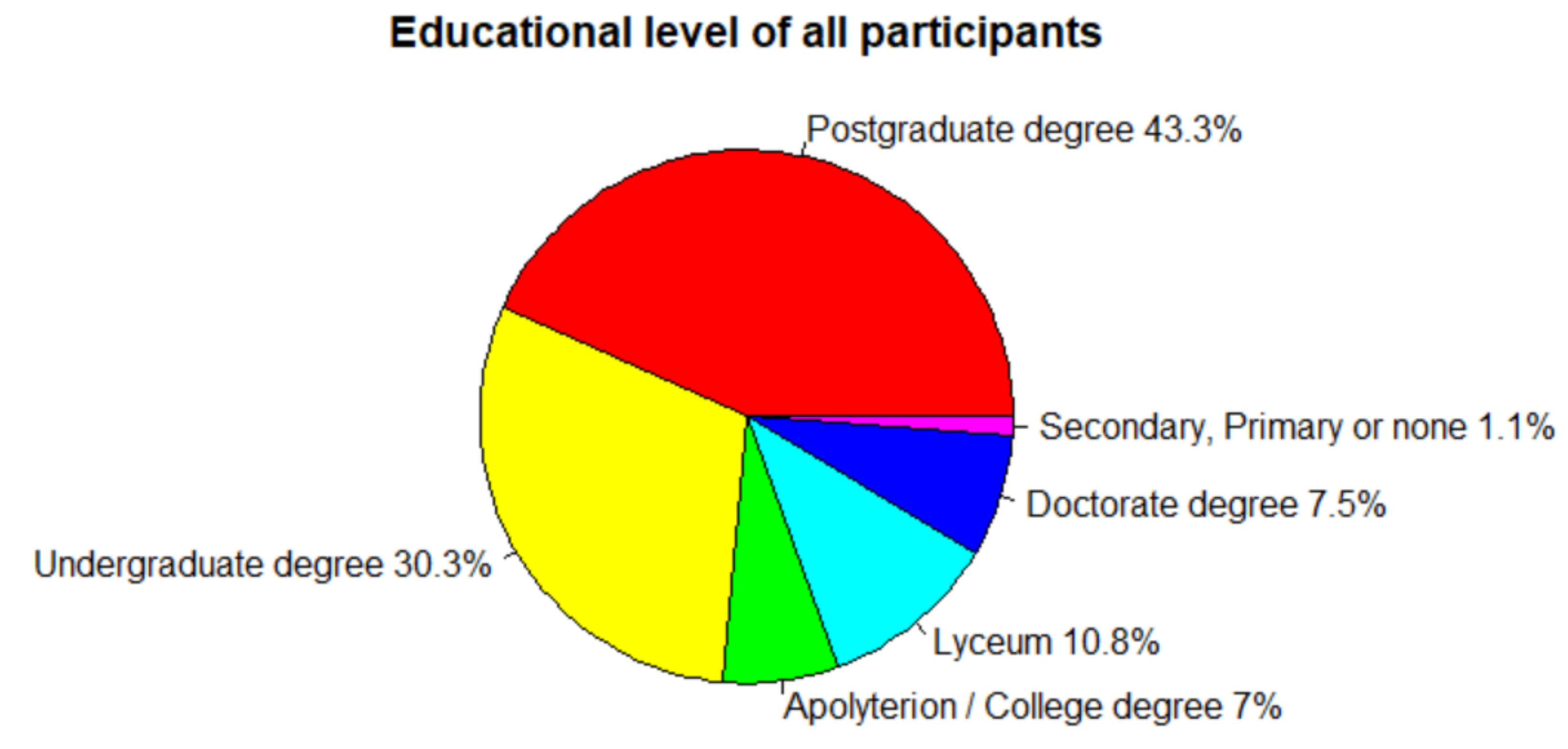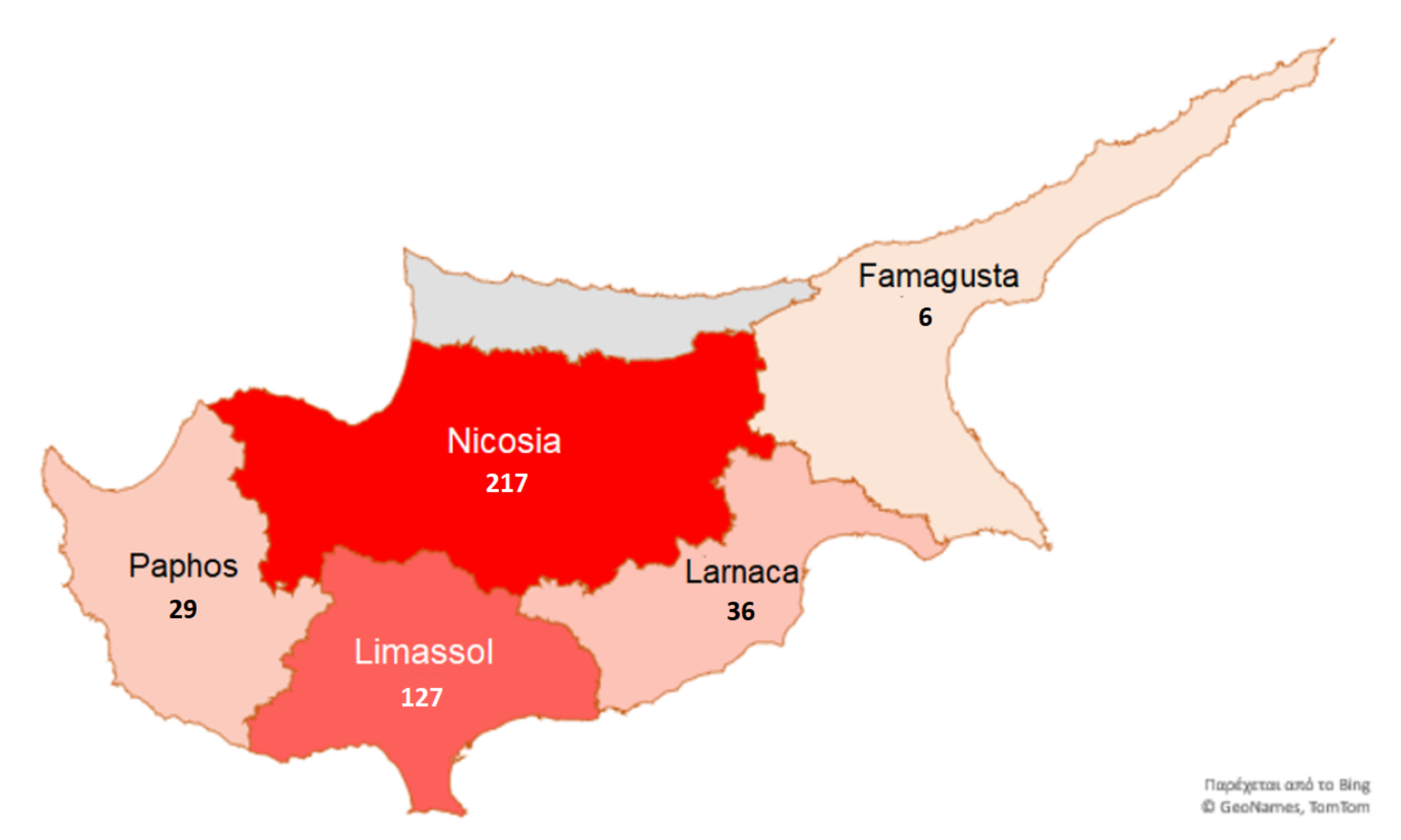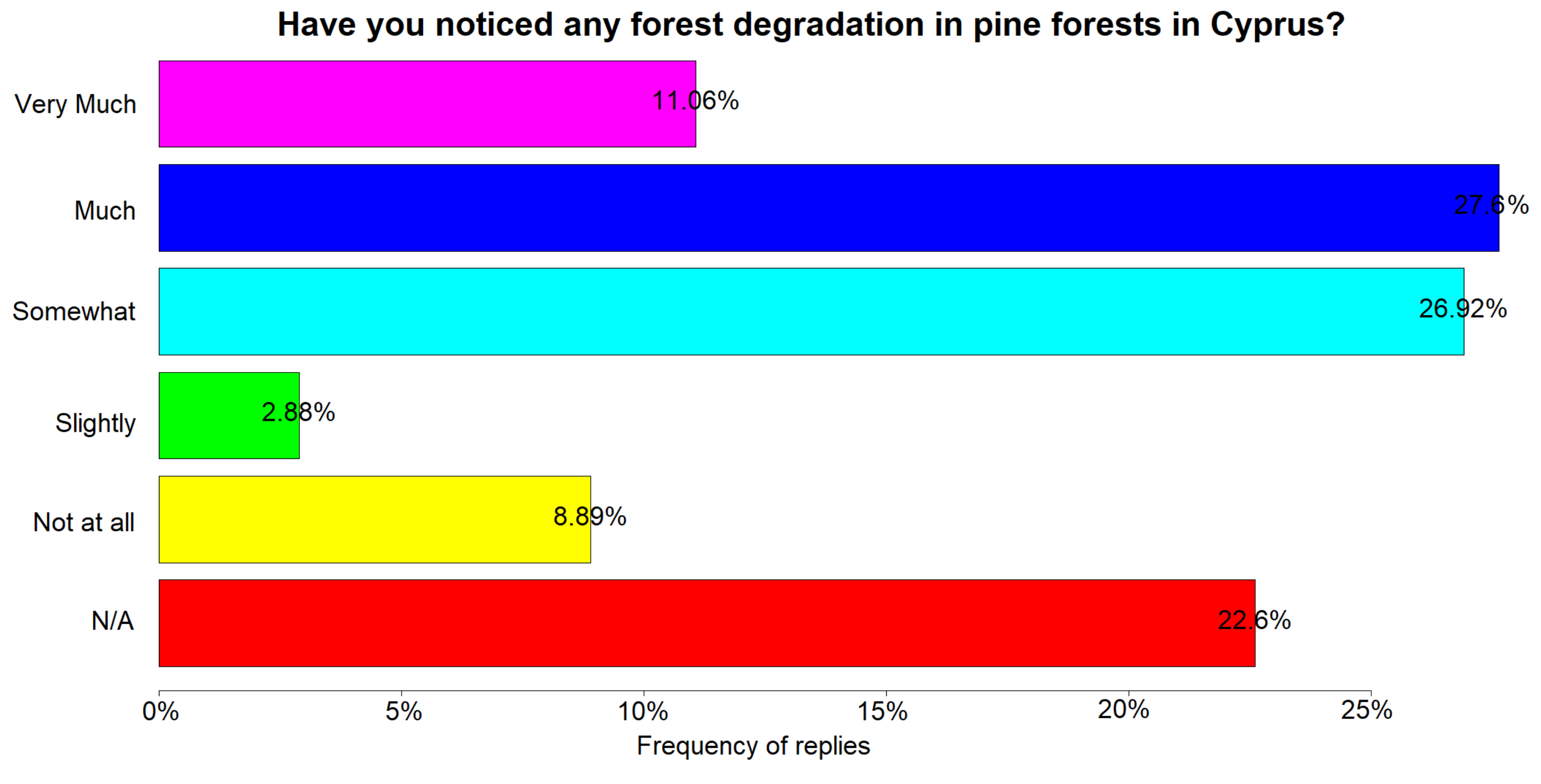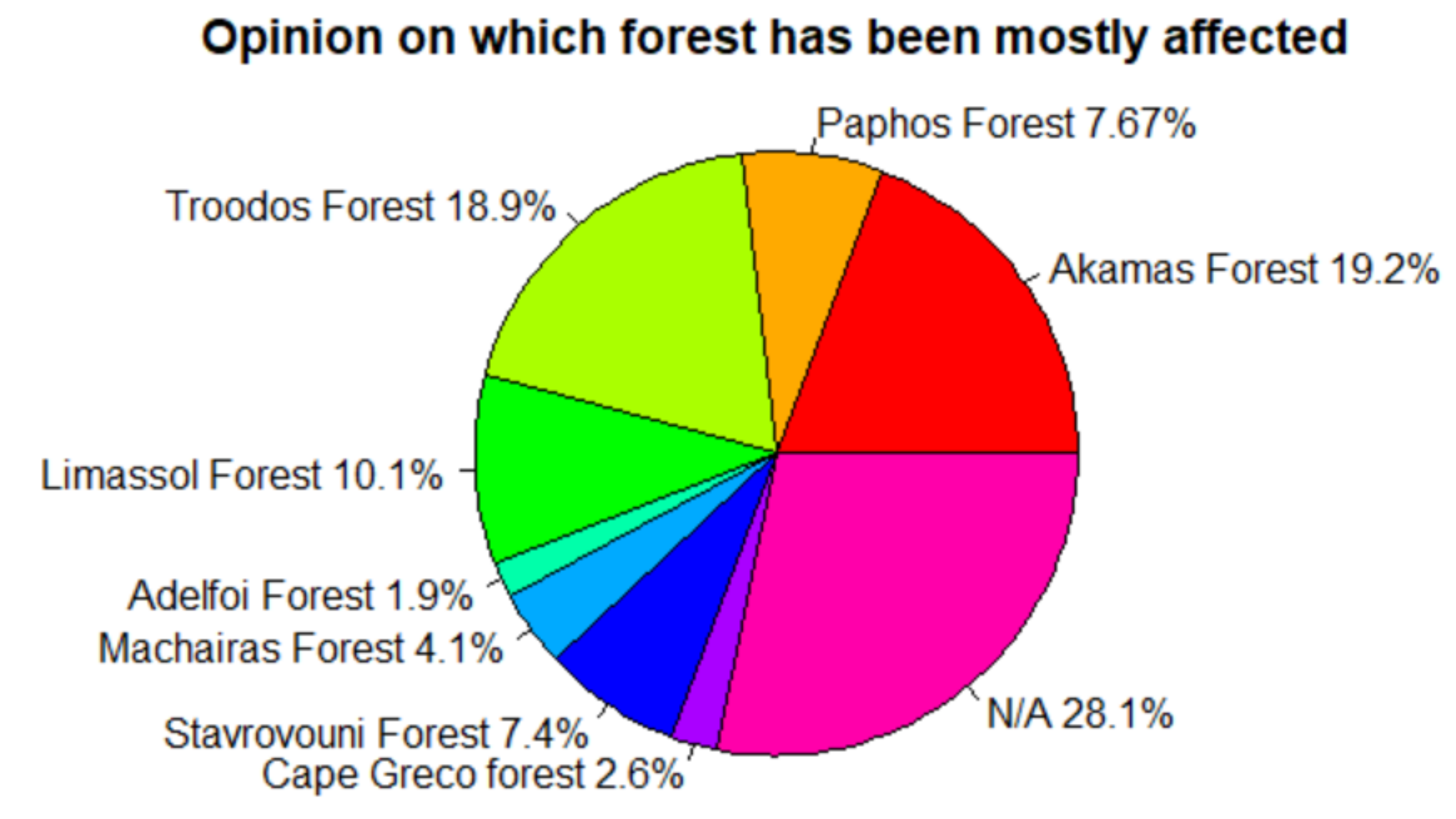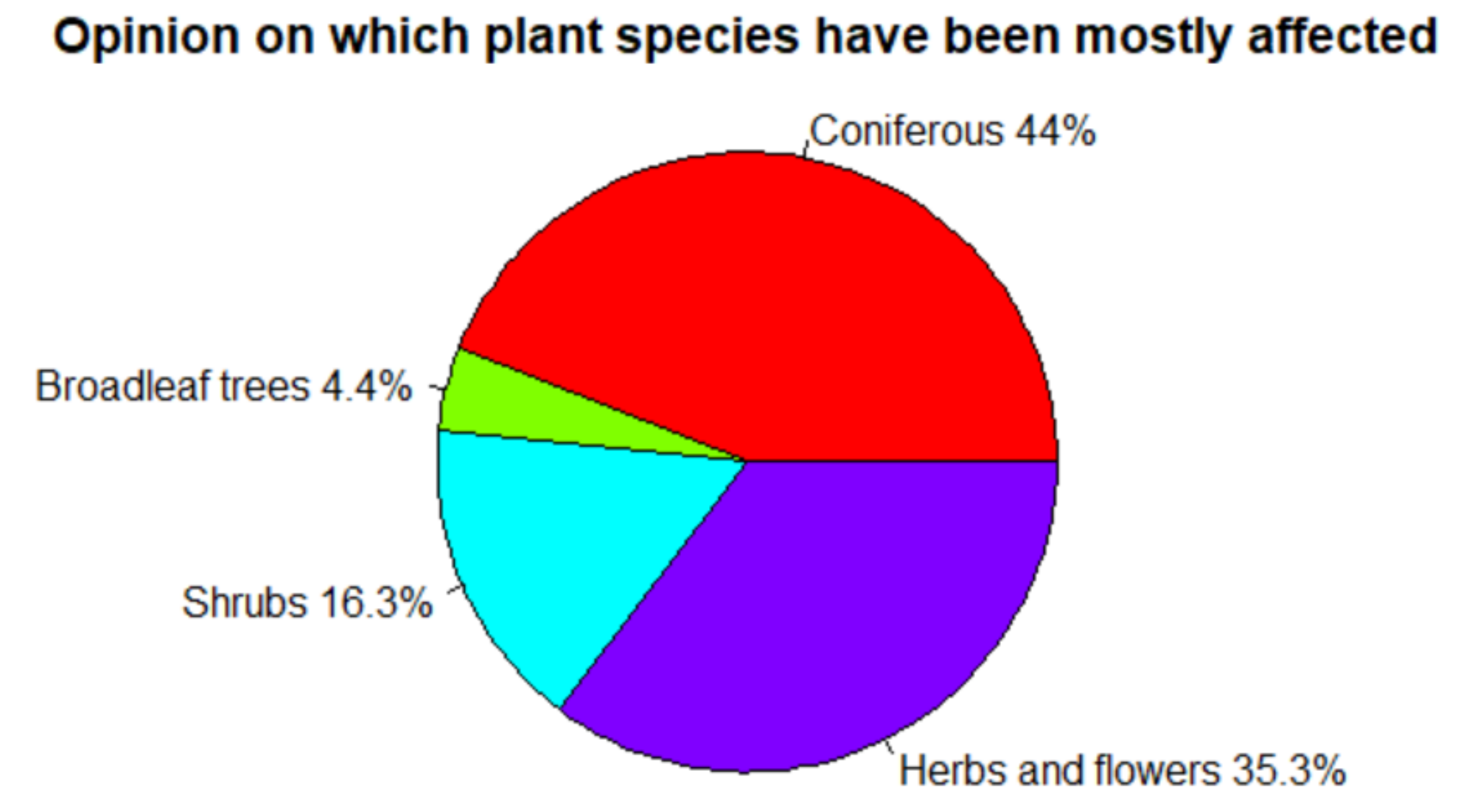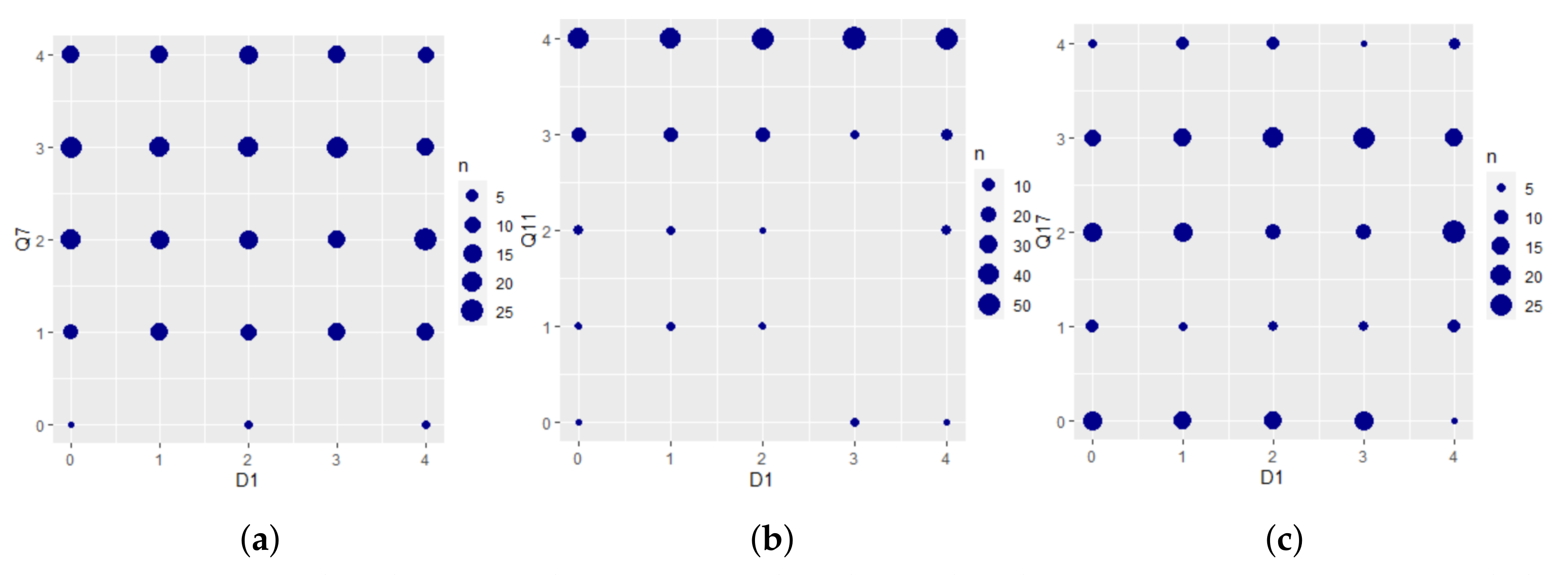1. Introduction
Globally forests provide an important environmental and ecological resource acting as carbon sinks and providing food, clean water and habitat for humans and many other species. Biodiversity plays a substantial role in ecosystem resilience [
1], while various human activities affect biological communities by altering their composition and leading species to extinction [
2]. This argument is also supported by the in-depth report on “Ecosystem Services and Biodiversity” published by the European Commission in May 2015; many anthropogenic factors threaten these ecological benefits because they result into growing concentration of atmospheric greenhouse gas that leads to global warming. Climate change is a significant factor of the increased forest fires and tree species being unable to adapt to the severity and frequency of drought during the summer period. A significant number of forest hectares in Europe has been lost or are threatened because of extreme forest fires (e.g., Cyprus [
3], Greece [
4], Portugal [
5]), and increased pests/diseases (e.g., bark beetles in Bulgaria [
6]). According to Read et al., 2009 [
7], the possibility of increased insect pests and tree diseases is high due trees been weakened by the extreme weather conditions.
Policy making and education plays a substantial role for mitigating the effects of climate change. For developing effecting educational and communicational approaches is essential to understand the perceptions of the public about climate change [
8]. Knowing what people think and understand about climate change, as well as to what extend they have observed forest degradation, is critical for implementing robust, tailored, acceptable and effective mitigation policies aiming to tackle the effects of climate change. Additionally Weber et al., 2010 [
9] claimed that there is a need of analysing the perceptions of scientists and the general public on climate change. They also stated that it is difficult for people to observe changes on phenomena caused by climate crisis. But nowadays do people observe the changes? Understanding whether changes and forest degradation is happening fast enough to be observable by the general public, as well as analysing what people believe about climate change is extremely important in policy making especially for countries, whose vulnerability to climate change has been highlighted.
Recent reports stressed the vulnerability of the forest ecosystem in the European Union (EU), especially to the south [
10,
11]. Impacts associated to climate change include incidence of pests, higher possibilities of forest fires, risk of coniferous forests decline and worsening the problem of invading species [
10]. Shoukri and Zachariadis, 2012, also highlighted that Mediterranean Europe is expected to experience the most adverse climate change effects compared to other European regions [
12]. This statement is further supported by Lider et al., 2008, who asserted that drought events are expected to be become more frequent and last longer in the Mediterranean region and this will lead to weakening of forest stands that could result in pest outbreaks [
13]. Furthermore, according to Hódar et al., 2003 [
14] the attacks of Thaumetopoea pityocampa to Scots pines (
Pinus sylvestris L.) has been increased in Mediterranean due to climate change. This results in a significant reduction in pine growth and some deaths. Furthermore, Cleland et al., 2007 [
15] showed that climate change confers shifts to blooming time [
15] and according to Wolkovich et al., 2012, the phenological responses (i.e., alternations in blooming timing) of plants to warmer conditions are unpredicted [
16]. Additionally, vegetation in mountainous areas could suffer more due to landslides and soil erosion [
17].
Cyprus is an island that lies in the north-eastern end of the Mediterranean sea [
18] (33
east of Greenwich and 35
north of the Equator) [
19] and a hotspot in respect to climate change vulnerability. According to Eratosthenes and other ancient statements, Cyprus was covered by dense forests including its plains [
20,
21]. Nevertheless, Cypriots peasants that inhabited the forests consumed them irresponsibly according to their agricultural and livestock needs, leading to forest devastation and shrinkage [
18]. The British administration introduced the first forest laws, established the Department of Forests, created a reforestation plan and promoted forest preservation [
22]. According to the supervisor A.K. Bovill and D.E Hutchins (1909)—as reported in a statement—the demarcated forests in Cyprus were 10.7% and 19% including shrub-forests [
21]. In 2008, the percentage of forested areas reported at [
19], was 18.7%. Additionally, between 2005–2008, prolonged droughts affected the forest ecosystems in Cyprus resulting into intense stress, increased competition between forest species, higher land temperature and low soil moisture [
23]. Shoukri and Zachariadis [
12] stated that climate change may alter forest species distributions, increase fire risk and tree mortality.
For mitigating climate change, the European Green Deal aims to have no net Greenhouse Gas emissions by 2050. From 28 EU countries, Cyprus had one of the lowest national targets (5%) for reducing carbon emissions until 2020 but at the same time, it was listed as one of the worst-performing countries; noting that from the worst-performing countries, Cyprus had the highest emissions [
24]. We can argue that the lack of environmental interest could be cultural related. Battagline and Barbeau [
25] showed that a high percentage of German winegrowers stated that would consider growing different varieties for climate change adaptation, while Italian and French winegrowers were hesitant. Despite the fact that the Mediterranean culture of Cyprus and Italy resembles, the trend of greenhouse emissions of Italy from 2013–20 was decreasing, while in Cyprus was increasing [
26,
27].
Considering the percentage of the remaining forests in Cyprus, the risk they face due to climate change and the low performance of the country in reducing carbon emissions for reaching EU targets, it is crucial to understand the perception of Cypriot Residents in respect to climate change for building a preservation plan tailored to each demographic category. Bostrom et al., 1994 [
28] and Read et al., 1994 [
29] evaluated what people know about global climate change. Yousefpour et al., 2015 [
30] targeted forestry professionals to understand their perceptions and forest-related adaptation strategies in south-west Germany. More specialised studies, examined how a person being affected by a natural disaster perceives and behaves in relation to climate change [
31,
32], while Crona et al, 2013 [
33] extracted and compared cultural knowledge to examine human perceptions related to it.
This study, raises the question of how Cypriot residents perceive climate change, whether they believe that it is important and whether they understand its impact on Cypriot forests. The goals of the study are the following:
Due to the slow adaptation in Cyprus, in comparison to other EU countries, we are investigating how Cypriot residents perceive climate change, whether they believe that it is important and whether they understand its impact on Cypriot forests.
In 2010, Weber et al. [
9] claimed that due to the slow rate of climate change, people are difficult to understand changes of phenomena. So, we want to examine if nowadays, people started observing the effects of climate change. The focus is on the forestry sector in a Mediterranean country that in comparison to other EU countries, Mediterranean countries are experiencing more intensively the harmful effects of climate change [
34].
An analysis relating to demographic categories is also performed to understand how the perceptions differ according to age, educational level and employability status.
A correlations analysis is performed to understand deeper the relationship between a selection of questions and the demographic data. For example, if they could be used for prediction.
The results were compared with the literature, and it was shown that some facts that experts suspected (e.g., observed reduced ability of regeneration [
23]) or stated (e.g., reduced soil moisture [
10]) in the literature were observed and noted by the participants of the questionnaire. The results derived could be used as scientific evidence for promoting environmentally friendly policies aiming to mitigate the effects of climate change, preserve a healthy ecosystem and consequently maintain social stability and stimulate economic growth.
4. Specific Forest Related Questions
It worth highlighting that in the general question on whether people have noticed any forest degradation in coniferous forests in Cyprus, 38.7% of the participant declared that they have noticed “Much” or “Very Much”, while another 26.92% indicated that they saw some changes (
Figure 5).
Significant attention was also drawn to the question asking people to write down what kind of forest degradation they had observed. A percentage of 36.06% of the participants (150 in numbers) included a reply. Most of the answers (31.33%) referred to drying trees either by providing the definition or by describing characteristics related to tree die-back. On top of that, further frequent replies included tree mortalities, soil erosion, drought, increased fire events, reduced soil moisture, and desertification. An important observation by the participants is the difficulty of coniferous forests to regenerate themselves. To be more precise 16 participants (10.67% of replies) either declared directly or indirectly that forests have difficulty regenerating themselves. Indirect replies included reduced blossoming and lack of young, regenerated trees.
Not to be missed is which areas people believe have been mostly affected as indicated in
Figure 6. Most people believe that the most affected forested areas are Akamas forest (19.2%) and Troodos forest (19%)—(
Figure 1 shows the locations of Akamas and Troodos forests). Finally, it is people’s answers on what they believed that the most affected plant species is. The majority (44%) stated that coniferous trees have been chiefly influenced, while 35.3% asserted Herbs and Flowers, 16.3% Broadleaf trees and 4.4% Shrubs (
Figure 7).
4.1. Results of Likert Scale Questions versus Demographic Categories
The Likert scale questions have been analysed according to the various democratic data.
Table 5,
Table 6 and
Table 7 present the percentages of the participants that replied positively (“Much” or “Very Much”) to the questions according to their “Educational Level”, “Age Category”, “Employability Status”. Due to an observed relationship between the beliefs of employed versus unemployed people,
Table 8 was created to analyse further and understand the potential correlation. The numbering of the questions in
Table 5,
Table 6 and
Table 7 is the same as the numbering used at the disseminated questionnaire and they are aligned with the supported data provided along with this paper. Additionally, question 10 and 11 refer to “above phenomena”, which according to the questionnaire are: (1) Increase in temperature, (2) Prolonged period of high temperatures, (4) More frequent and more intense heat waves, (5) Reduction in annual precipitation and (6) More intense precipitation (extreme precipitation).
4.2. Scatter-Plots and Correlation Coefficients
This section shows the scatter-plots generated and provides the
Spearman rank coefficient correlations derived.
Figure 8 shows the scatter-plots generated for visually observing the relation between the “D1: Age Categories” and the three selected questions.
Figure 9 shows the scatter-plots generated for observing “D2: Educational level” in relation to the three selected questions.
Table 9 contains the
Spearman rank correlation coefficients between three demographic categories (“D1: Age Category”, “D2: Educational level” and “D3: Employability Status—Employed or Not”) and three Likert scale questions were selected:
The significance values (
p-values) of the coefficients are also denoted in
Table 9. Correlations whose
p-value is below 0.05 are considered statistically significant. It was shown that correlations of moderate and weak correlations are statistically significant, while combinations that indicated no correlation are not considered statistically significant.
6. Conclusions
Climate change is universally recognized as a global issue of emergency as it could confer severe consequences for humanity and ecosystems [
49]. Scientists have been monitoring, ongoing and future patterns of climate change and their effects at global and regional scales [
50]. It is of crucial importance to develop localised policies and educational plans tailored to the understanding of the general public. This study measured through questionnaires what Cypriot residents believe about climate change and whether they have observed forest degradation. The responses were compared among various demographic categories (age, education and employability status). The question on whether they noticed degradation on Cypriot coniferous forest received 65.62% responses stating “moderate”, “much” or “very much”. A potential degradation reason was written down by 150 people, of whom 31.33% referred to tree die-back, while many stated decreased soil moisture and difficulty in regeneration. These degradation reasons were either suspected or noted in the literature [
23,
51]. Webel et at., 2010 [
9] stressed the importance of comparing perceptions of scientist and general public and doubted that the general public was able to observe climate change on phenomena. In contrast—and after 10 years—in this study, we found that a small percentage of the general public was able to observe specific phenomena (e.g., reduced soil moisture), while a significant percentage noticed forest degradation. Employed people were also more likely to believe that climate change is important, raising the question whether believing in climate change is a personality trait that increases employability.
With respect to future directions, it will be interesting to see after a few years how the perceptions of people would have modified; whether they may observe more forest degradation and whether they may be more convinced about the importance of climate change. Another research direction is to look further into the employability perceptive and how the beliefs of people about climate change may increase their employability. Not to be missed is the comparison of perceptions between multiple countries for understanding how cultural differences influences people’s beliefs on the subject; this will help tailor education and policies for each country and possibly help the worst-performing countries, like Cyprus, to reach their Green Deal targets. This will contribute into preserving a healthy ecosystem that will maintain social stability and stimulate economic growth. In parallel, these data could be used as scientific evidence for promoting environmentally friendly policies aiming to mitigate the effects of climate change.
